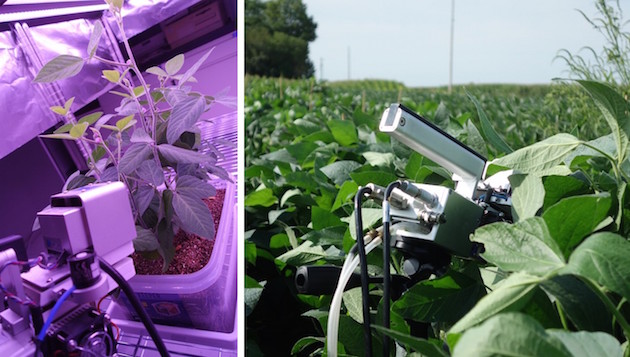Improvement of the soybean photosynthetic capacity and productivity through analyzing the dynamics of the leaf photosynthesis
Project Gist
The responses of the soybean leaf photosynthesis against the fluctuating light intensity in the field
Keywords
leaf photosynthesis, photosynthetic induction response, soybean, light environment
Background and Purpose
The leaf photosynthetic rate is the fundamental process of the biomass production of the crop plants. There have been many studies aimed to enhance the crop productivity through the enhancement of the leaf photosynthetic capacity under the optimal condition. On the other hand, it is often overlooked that the plans in the field are subjected to the dynamic change of the light intensity due to the cloud or the self-shading of the plants. Little is known about the response of the photosynthesis against the sudden increase of the light intensity (“photosynthetic induction response”). This study aimed to elucidate the genetic diversity of the photosynthetic induction response among various soybean genotypes, and to clarify the physiological mechanisms underlying that variation. To achieve this, this project was conducted by the collaboration between Kyoto University, the University of Illinois Urbana-Champaign, and Michigan State University, USA.
Project Achievements
There was a large variation of the photosynthetic induction response against the sudden increase of the light intensity among soybean genotypes. This is the first report to elucidate the significant variation of the photosynthetic induction response in the single plant species. The observed difference was mainly attributed to the activation speed of the Rubisco enzyme in the leaf. These findings are expected to contribute to the soybean breeding programs in the future to achieve the further increase of the productivity. Through the project, the collaboration networks across Japan and USA was established. This network will be a platform for the innovation on the photosynthetic study on the crops in the future.
Future Prospects
The physiological and genetic mechanisms of the photosynthetic induction response in soybean will analyzed. The impact of the photosynthetic induction response on the dry matter productivity will also evaluated in the field condition. Rice, which is the most important crop in Japan, will be the next target crop for the study of the photosynthetic induction response.
Figure

Principal Investigator

・TANAKA Yu
・Graduate School of Agriculture
・The research topic of Yu Tanaka is the natural variation of the leaf photosynthetic capacity in rice and soybean. The physiological and genetic mechanisms underlying the variation of the leaf photosynthesis is also the important target. The final objective is to achieve the increase of the crop productivity through the enhancement of the leaf photosynthesis.
・http://www.cropscience.kais.kyoto-u.ac.jp/
